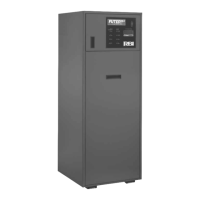
Do you have a question about the RBI FUTERA II Series and is the answer not in the manual?
| Brand | RBI |
|---|---|
| Model | FUTERA II Series |
| Category | Water Heater |
| Language | English |
Recommends a level, central location with good access, protected from water and excessive moisture.
Stresses adherence to National Fuel Gas Code (NFPA 54) and local building codes.
Covers pipe material, length limits, insulation, pitch, and termination requirements for horizontal vents.
Details pipe length, insulation requirements, and termination for vertical direct vent systems.
Explains the use of a power venter for negative pressure systems and pipe requirements.
Outlines needs for negative pressure, barometric damper, and chimney draft.
Specifies clearances from buildings, overhangs, and prevents ingesting flue gases.
Outlines steps for removing or testing appliances in a common venting system.
Details visual inspection, draft testing, and spill detection for common vent systems.
Mandates installation according to ANSI/ASME, local codes, and clearances to combustibles.
Details pump sizing for continuous flow, overcoming head loss, and achieving temperature rise.
Highlights CSA certification for outdoor use and risks associated with freezing.
Emphasizes the necessity of maintaining continuous water flow through the unit.
Explains the flow switch's role in preventing firing without adequate water flow.
Mandates adherence to ANSI/ASME standards, local codes, and clearances for piping.
Details sizing of supply and return connections based on system requirements and Table 4.
Covers pump sizing for continuous flow, head loss, and temperature rise, referencing Table 5.
Specifies maximum allowable temperature rise and its relation to flow rate.
Explains the use of primary/secondary piping for systems with zone valves or pumps.
Describes using a dedicated pump for constant boiler flow and secondary pump sizing.
Ensures domestic hot water does not exceed 130°F to prevent scald injuries.
Requires bronze headers and components suitable for potable water use.
Discusses how water hardness, dissolved solids, and pH affect heat exchanger performance and longevity.
Explains how to prevent condensation and maintain optimal water velocity for efficiency.
Ensures correct gas type usage and compliance with National Fuel Code and local regulations.
Specifies minimum required gas pressures for natural gas and propane.
Guides proper gas piping sizing using Tables 6 and 7 considering fittings and demand.
Instructs users to read the manual and ensure the unit is installed correctly before operation.
Highlights propane's properties (heavier than air) and safety measures for leak detection.
Provides a step-by-step guide for lighting the pilot and starting the main burner.
Covers initial adjustments for satisfactory combustion using a manometer and analyzer.
Guides the process of testing and adjusting main burner pressures (high and low fire) per Table 8.
Details performing flue gas analysis (CO2) and adjusting the air damper for optimal combustion.
Guides setting the operating control to the lowest temperature satisfying consumer needs.
Describes the function, adjustment, and maximum setting of the high limit aquastat.
Provides step-by-step instructions for safely removing, inspecting, and reinstalling the burner.
Guides inspection of the heat exchanger for signs of damage, sooting, or corrosion.
Troubleshooting steps for igniter not sparking or grounding problems during ignition.
Verifies no leaks, correct manometer installation, wiring, and fan operation before startup.
Ensures proper pilot adjustment, spark strength, and multiple ignition advances.
Records manifold pressure, O2/CO2 levels, efficiency, and temperatures for combustion analysis.
Verifies low water cutoff, gas pressures, and high limit settings prior to commissioning.
Involves removing manometers, correcting settings stickers, and replacing covers.
Ensures all valves are adjusted, the pump is running, and the user is instructed on operation.
